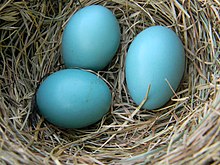| Robin egg blue | |
|---|---|
 American robin eggs | |
| | |
| Hex triplet | #00CCCC |
| sRGB B (r, g, b) | (0, 204, 204) |
| HSV (h, s, v) | (180°, 100%, 80%) |
| CIELChuv (L, C, h) | (75, 59, 192°) |
| Source | Crayola |
| ISCC–NBS descriptor | Brilliant bluish green |
| B: Normalized to [0–255] (byte) | |
Robin egg blue, also called eggshell blue or robin's-egg blue, [1] is a shade of teal (a blue-green color), approximating the shade of the eggs laid by the American robin, an abundant songbird of North America. The egg pigment is biliverdin, a product of the breakdown of heme. [2]
Contents
The first recorded use of robin egg blue as a color name in English was in 1873, [3] though earlier references in English to colors similar to that of robin's eggs were made as early as 1844. [4] The "robin's egg" glaze appeared during the Yongzheng Emperor’s reign (1722-35) in China, and Yixing potter Hua Fengxiang made works with "robin's egg" glaze. [5]
